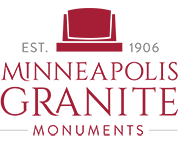Monument Terms
Sandblasting is the process using an air compressor and sand to blast unprotected areas of the stone. This etches the artwork and information into the stone while leaving the rest of the stone protected.
Shape carving is the process of using a specialized air compressor to gently craft sand blasted designs into a 3-dimensional shape.
Laser etching is a design service that uses a machine to etch a photographic image onto a jet black stone.
Our on-staff artist uses diamond tipped knives to draw on the stone to produce hand etched artwork.
Setting is the monument industry term for installation. Monument setters install monuments in cemeteries.
The foundation is made of either concrete or granite. It is what the base and tablet sit on top of. It comes included with the purchase of any monument.
Serpentine, or serp, refers to the curved shape of the top of a monument. This bell curve shape is the standard shape of a monument.
Cemetery lettering is the service of traveling to cemeteries with portable air compressors and air hoses to blast in designs and dates in the cemetery itself.
That is where the upright tablet is polished on all 5 sides – front, back, left and right side, and top.
The upright tablet is polished on only 3 sides – front, back, and top. It is rock pitched on the left and right side.
The upright tablet is polished on only 2 sides – front and back. It is rock pitched on the left side, right side, and top.
Rock pitching is the action of taking a chisel and hammer and breaking away the stone leaving a rough, rocky surface know as rock pitch. You can decide on the finish of your monument, meaning if you want the sides to be rock pitch or polished.
A standard base has a polished top and is rock pitched on all four sides. A base with a 2″ polished margin has the top 2″ of the base polished on either one or all four sides.

